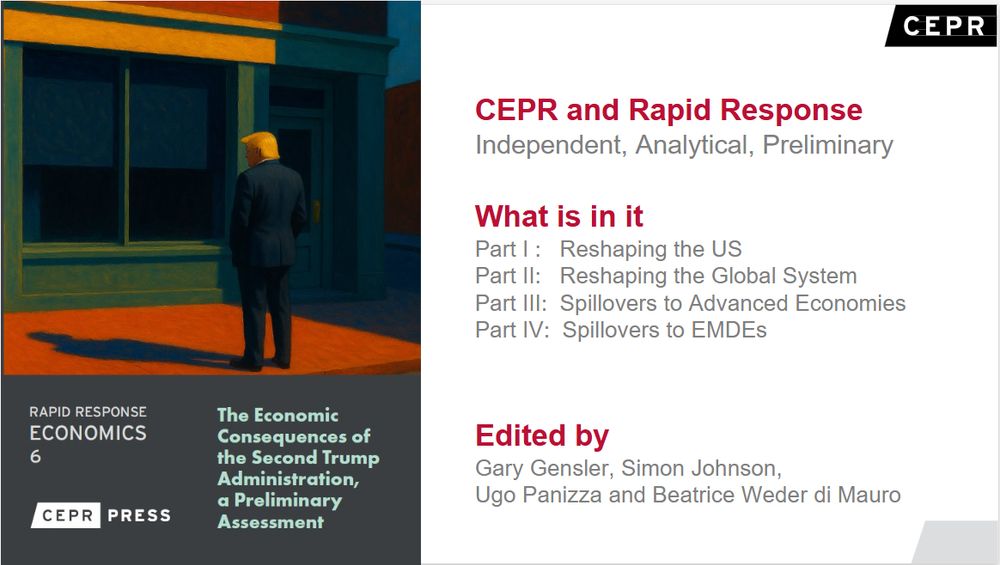They say their approach is “conservative” but it differs from that of the Chicagoans who have been the primary conservative voices since the Reagan admin. Instead, Trumpian populist rhetoric on antitrust reflects New Right thinking and recalls the Lochner era of constitutional interpretation. 2/3
05.11.2025 16:17 — 👍 0 🔁 0 💬 1 📌 0
My new article “Trumpian Populism and the Changing Intellectual Landscape in Antitrust: Century-Old Resonances, the New Right, and the Possible End of an Era” looks at the views of current senior antitrust enforcement officials. 1/3
05.11.2025 16:17 — 👍 1 🔁 0 💬 1 📌 0
The HMT refines the demand substitution focus in the caselaw (e.g., duPont (Cellophane)) by suggesting a conceptual metric to determine how much demand substitution is too much to define a market. Looking just to Brown Shoe doesn't tell you how to think about that.
26.09.2025 19:33 — 👍 1 🔁 0 💬 1 📌 0
I see the HMT as differing from Brown Shoe for a different reason: The HMT looks only to evidence about a single economic force, demand (buyer) substitution, while some Brown Shoe factors are about other economic forces. As you say, both approaches integrate qualitative & qualitative evidence.
26.09.2025 19:32 — 👍 1 🔁 0 💬 1 📌 0

Abstract of "New Economic Forces Behind the Value Distribution of Innovation." Advances in a general-purpose technology (GPT) enable many firms to invent complementary inventions, or co-inventions, making the GPT more valuable. This study examines the empirical implications of a straightforward model in which firms choose either incremental or novel co-invention. Incremental co-inventors aspire to small gains at low costs and with less uncertainty. Novel co-inventors introduce new products or services with the potential for large returns, but do so at high costs and with uncertain outcomes. Similar firms investing in incremental co-invention will create value proportional to their existing business, a benchmark we illustrate with the experiences at local radio and newspapers. The study then examines the value of co-inventions for the World Wide Web and mobile ecosystems, focusing on success in 2013, using data from many sources. This data supports analysis comparing the incremental and novel regimes. The latter should display a distinctly different up! per tail of the distribution of returns. We show that the value distributions for incremental and novel co-invention are far apart. Incremental co-invention is more widely distributed across regions, industries, and firms. Success from novel co-invention is rare, challenging, and the source of the largest value. In the aggregate, novel co-invention creates the most value, so the overall value distribution remains concentrated in a few industries, regions, and firms.
New Working Paper! Lucky to work with Shane Greenstein @shanegreenstein.bsky.social and Pai-Ling Yin on "New Economic Forces Behind the Value Distribution of Innovation." Abstract and link follow.
lnkd.in/ew6UHk3v
08.08.2025 21:37 — 👍 7 🔁 1 💬 1 📌 1
Looming problems from BLS statistics politicization. Social security benefits and many long term labor market contracts are indexed to the CPI. BLS makes the CPI. Recipients care about indexed cost of living increases, a lot.
/1
04.08.2025 21:50 — 👍 193 🔁 71 💬 8 📌 9
Agreed—market def in this case seems too fact-bound to be a good candidate for cert.
03.08.2025 20:58 — 👍 0 🔁 0 💬 0 📌 0
Nested markets are fine if the facts support both. I could imagine, for example, markets for colas, all soft drinks, and all beverages. If all satisfy the hypothetical monopolist test, conduct that harms competition in any one of them (or more than one) would presumably violate the antitrust laws.
03.08.2025 17:04 — 👍 2 🔁 0 💬 0 📌 1
Looking at Merger Review from Outside an Ivory Tower
This article reviews Louis Kaplow, Rethinking Merger Analysis (MIT Press 2024). The review evaluates the book's discussion of five major topics:&
I recently reviewed Louis Kaplow’s book "Rethinking Merger Analysis." The review evaluates the book’s discussion of market definition, coordinated effects, entry, efficiencies, and the welfare standard. Available in The Antitrust Source or at ssrn.com/abstract=533...
21.07.2025 18:41 — 👍 3 🔁 1 💬 0 📌 0

Lunch with some DC area antitrust professors. With @profgavil.bsky.social @lancierifilippo.bsky.social Dale Collins and @stevesalop.bsky.social
24.06.2025 19:12 — 👍 3 🔁 0 💬 0 📌 0

While the second Trump administration's initial moves in #antitrust enforcement suggested continuity, more recent actions outside the realm of antitrust enforcement have the potential to change #competitionpolicy dramatically, explains @jbbecon.bsky.social.
cepr.org/publications...
#EconSky
24.06.2025 13:41 — 👍 1 🔁 1 💬 0 📌 0

📢 New CEPR #eBook out NOW! 📚
"The Economic Consequences of the Second Trump Administration: A Preliminary Assessment"
Editors: Gary Gensler, @simonhrjohnson.bsky.social, @upanizza.bsky.social, @wederdim.bsky.social
Free download: cepr.org/publications...
#EconSky
18.06.2025 10:12 — 👍 6 🔁 6 💬 0 📌 1

Digital Platform Regulation
I have a new book! Digital Platform Regulation. Fun analysis of what society should do to get some competition out of of our favorite gatekeeper platform. Relevant to the DMA and US antitrust remedies. And free! Download here:
som.yale.edu/centers/thur...
04.06.2025 21:08 — 👍 53 🔁 18 💬 1 📌 2
Slater’s perspective favors strong antitrust. But it’s natural to wonder whether liberty protection—the intellectual basis for what she calls a new right realignment in antitrust—would, like Lochner era thinking, now justify non-antitrust policies to circumscribe social & economic regulation. 5/5
29.04.2025 14:28 — 👍 1 🔁 0 💬 0 📌 0
Slater also recalls the 19th c in her populist framing of antitrust as supporting “forgotten men and women”—for her consumers, workers, and small businesses and innovators in Little Tech, manufacturing, and family farms—against private monopolies, particularly “online platforms” 4/5
29.04.2025 14:28 — 👍 1 🔁 0 💬 1 📌 0
That view animated the Supreme Court’s 1899 Addyston Pipe decision, a leading antitrust precedent still read today written by Justice Rufus Peckham. Peckham famously supported expansive substantive due process protection for contract and property rights. 3/5
29.04.2025 14:28 — 👍 0 🔁 0 💬 1 📌 0
Slater emphasizes that individual liberty is threatened by “corporate tyranny” just as it is threatened by government tyranny. Similarly, the Lochner era Supreme Court objected to all artificial interference with the market, public or private, as inconsistent with the “liberty of contract.” 2/5
29.04.2025 14:28 — 👍 0 🔁 0 💬 1 📌 0

Six years old…and still worth reading 🙂
23.04.2025 15:32 — 👍 4 🔁 1 💬 0 📌 0
Not a Simple Story of Big Business Capture: An Essay on the Political Economy of Antitrust
This essay questions a political economy theory that views U.S. antitrust institutions as having been captured by big business around the late 1970s. It explain
I gave a list of examples such as unilateral effects of mergers and raising rivals' costs analysis, and said "Those developments often moved the law and enforcement in a direction counter to the distributional interest of big business." From ssrn.com/abstract=449... 4/4
05.02.2025 18:16 — 👍 0 🔁 0 💬 0 📌 0
On the role of economics, I wrote in 2023 that "the big business capture theory cannot readily rationalize the not insubstantial influence ... of developments in economics since the 1970s that called into question non-interventionist perspectives" 3/4
05.02.2025 18:16 — 👍 0 🔁 0 💬 1 📌 0
Finding Common Ground Among Antitrust Reformers
This forthcoming article explains why antimonopolists (neoBrandeisians) and post-Chicagoans (centrist reformers) should work together to advance both groups’ go
..."Trump has organized his political movement around cultural and identity issues, not economic issues.”
Both quotes from ssrn.com/abstract=414... I also noted differences between the economic interests of Trumpian populists and big business. That's not saying big business favors democracy. 2/4
05.02.2025 18:16 — 👍 1 🔁 0 💬 1 📌 0
Finding Common Ground Among Antitrust Reformers
This forthcoming article explains why antimonopolists (neoBrandeisians) and post-Chicagoans (centrist reformers) should work together to advance both groups’ go
On democracy, here's what I wrote in 2022 (before Trump began to work with Musk): "[T]he imminent threat to democracy comes from authoritarians, not from the political power of large firm interests—at least so long as big business avoids making common cause with Trumpian populists." 1/4
05.02.2025 18:16 — 👍 1 🔁 0 💬 1 📌 0
Policy issues: the practical ability of courts to deter harmful conduct, error cost considerations, and non-economic values. Legal issue: whether Rambus v. FTC, a unilateral conduct case requiring increased market power to flow from lessened competition, extends to merger and agreement cases. 8/9
27.01.2025 21:21 — 👍 2 🔁 0 💬 1 📌 0
Lessened competition can generate increased market power, but it is not the only mechanism that can lead to that outcome. Whether the antitrust laws should reach conduct where increased market power does not flow from lessened competition turns on legal and policy considerations. 7/9
27.01.2025 21:21 — 👍 0 🔁 0 💬 1 📌 0
Senior meteorological scientist at @windbornewx.bsky.social & web developer
Law professor at the American University Washington College of Law (but all views expressed here are my own); author of Fintech Dystopia and Driverless Finance; mythbusting crypto, AI, and other fintech
Internet serial: fintechdystopia.com
Carl Oppedahl at https://blog.oppedahl.com
The official "Resistance" team of U.S. National Park Service. Our website: www.ourparks.org
I’m a law-themed discovery bot built by @davidcolarusso.com. Follow me to add a dash of law talk to your timeline—roughly 60 posts/day. Approximate algo: follow law folks; share new & popular posts.
Daily digest: https://icymilaw.org (news & scholarship)
Emeritus professor of constitutional law, including free expression and comparative constitutional law. Still trying to stay intellectually active.
CEPR, established in 1983, is an independent, non‐partisan, pan‐European non‐profit organization. Its mission is to enhance the quality of policy decisions through providing policy‐relevant research, based soundly in economic theory.
Charles W. Eliot Professor and President Emeritus at Harvard, former Secretary of the Treasury for President Clinton
Economist at Carnegie Mellon focusing on organizations and incentives, markets, competition, and antitrust, and health care. Formerly at the Antitrust Division, DOJ and at the FTC. Daf Yomi learner. Antitrust, Economics, Talmud puns.
CFR fellow, Washington Post columnist. Pulitzer finalist for biography. Author: REAGAN: HIS LIFE AND LEGEND, NYT bestseller and NYT 10 best books of 2024. Man of many hats. Repost ≠ endorsement. maxboot.net.
Law prof at UCLA. Posting about health law, policy & ethics, public health, global health, social & legal epidemiology
Lois Lane for the courts and broken tigger
Slate, Amicus, MSNBC, NYT bestseller Lady Justice
Political Scientist (all views are own, not employers’). Visiting Prof @ Columbia SIPA; civ-mil relations, military orgs/manpower, public opinion, foreign policy, militarized policing, democratic theory, intl/natsec law, pol econ
After teaching and writing about constitutional law for 50 yrs, it seemed time for me to reach beyond Harvard’s walls — to spread understanding and appreciation of the rule of law, of justice as fairness, and of a republic if we can keep it
Pulitzer prize winning Editorial Cartoonist
Open Windows at http://anntelnaes.substack.com
Archived work at http://anntelnaes.com
Economist at the UK Competition and Markets Authority. Interested in firms, productivity, markets, management and growth. Previously at ONS, Nuffield College Oxford. All views my own.
www.jakobschneebacher.com
American novelist noted for dense and complex novels
Parody?









